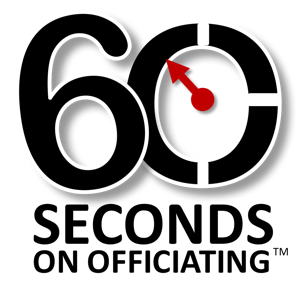
Up To Your Elbows
In Rules Knowledge
The revered Civil Rights leader, Dr. Martin Luther King Jr., is noted for having proclaimed, “the moral arc of the universe bends at the elbow of justice.”
Now in the world of basketball officiating, the arc of fair play is shaped by how quickly and accurately referees can evaluate conduct that violates the rules of our great game, in particular, that which centers around the swinging or movement of a player’s elbows/arms.
With the growing awareness of the long-term impact of concussions and head trauma to athletes, the NFHS Rules Committee highlighted the concern and listed contact above the shoulders as a Point of Emphasis (POE) to start the 2012-13 season. The POE defined the illegal contact from moving or swinging elbows/arms to be ruled as either an intentional or flagrant foul. At the time, the POE made special note of distinguishing between excessive movement/swinging of a player’s elbows, and movement that is not viewed as excessive.
Positioning and judgment are critical components factoring into an official preparing to blow his/her whistle to rule on arm/elbow movement by a player; but it is equally important to know the parameters for ruling on what you just witnessed after you blow your whistle.
First, is the swinging/movement of the arm/elbow a violation or a foul?
If there is no contact to an opponent, there is no foul to consider, so you are evaluating whether the arm/elbow movement is normal or excessive…If it is a normal basketball movement, you should let play continue. If you deem the movement to be excessive, you should rule the action to be a violation.
Speed of the arm movement, perhaps the proximity of an opponent, and a quick assessment of the player’s demeanor, can be two helpful guidelines to use in determining if the player’s arm/elbow movement warrants a whistle.
However, if a player’s (A-1) arm/elbow movement makes contact with an opponent above the shoulders, you need to quickly determine if the contact was the result of a normal basketball move or excessive movement.
If you view the movement as part of a normal basketball move (NOT excessive) , then A-1 should be charged with an intentional foul. Now your habit and instincts may reflexively draw you to want to rule this as simply a player control foul; but contact above the shoulders warrants a stiffer penalty in this age of enlightenment as it pertains to player safety.
Now if the swinging of A-1’s arm/elbow in a rapid movement is judged to be excessive, and he/she makes contact with an opponent above the shoulders, this action would warrant A-1 to be charged with a flagrant foul and he/she would be disqualified.
You would be well served to confer quickly with your partner/partners if you believe the movement is excessive, because you can’t “unring the bell” of ejecting a player, which may carry additional penalties from the school or athletic association, beyond the game he/she is departing.
As officials striving to keep fair balance on an even keel, we need to be mindful of a player swinging his/her elbows as an illegal barrier to prevent an opponent from moving closer to defend or steal the ball, which increases the chances for an opposing player being struck and injured with a wayward elbow. And there certainly is no place in our game for a player who may choose to use his/her elbows as a weapon of intimidation or to deliver their own form of punishment.
Rule knowledge and great court positioning will give you the confidence to properly rule on all scenarios pertaining to elbow and arm movement that may, or may not, result in contact above the shoulders.
So go forward to rule confidently and competently in this area, and remember, that the justice for swinging elbows is in the arc of your universe!
NFHS Rule Reference
4-19-3D; 9-13-1

Alot of post players after grabbing a rebound. Like to spread there elbows outward to protect themselves, from defense making a play on the ball. A1 grabs rebound, spreads elbow, no swinging, A1 in his area of space. B1 coming from behind, trying steal ball, makes contact with a1 elbow. This is a legal offense of by a1. Should be b1, be given a foul.
Julianleyva331@yahoo.com 30
Julian, This is a common play, and a rule of thumb on this play is if the elbows are swinging faster than the hips, then those are swinging elbows. If contact is made, yes, foul. Now, excessive, with no contact, is a judgement call. If you determine that it’s excessive, it’s excessive. Whistle the violation once and it will stop for the rest of the game.